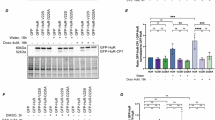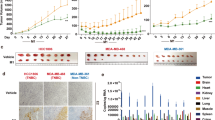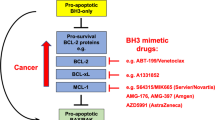Abstract
Inhibitors of programmed cell death (apoptosis) aberrantly prolonging cell viability may contribute to cancer1 by facilitating the insurgence of mutations and by promoting resistance to therapy2. Despite the identification of several new apoptosis inhibitors related to bcl-22,3 or to the baculovirus IAP gene4–9, it is not clear whether apoptosis inhibition plays a general role in neoplasia. Here, we describe a new human gene encoding a structurally unique IAP apoptosis inhibitor, designated survivin. Survivin contains a single baculovirus IAP repeat and lacks a carboxyl-terminal RING finger. Present during fetal development, survivin is undetectable in terminally differentiated adult tissues. However, survivin becomes prominently expressed in transformed cell lines and in all the most common human cancers of lung, colon, pancreas, prostate and breast, in vivo. Survivin is also found in approximately 50% of high-grade non-Hodgkin's lymphomas (centroblastic, immunoblastic), but not in low-grade lymphomas (lymphocytic). Recombinant expression of survivin counteracts apoptosis of B lymphocyte precursors deprived of interleukin 3 (IL-3). These findings suggest that apoptosis inhibition may be a general feature of neoplasia and identify survivin as a potential new target for apoptosis-based therapy in cancer and lymphoma.
This is a preview of subscription content, access via your institution
Access options
Subscribe to this journal
Receive 12 print issues and online access
$209.00 per year
only $17.42 per issue
Buy this article
- Purchase on SpringerLink
- Instant access to full article PDF
Prices may be subject to local taxes which are calculated during checkout
Similar content being viewed by others
References
Thompson, C.B. Apoptosis in the pathogenesis and treatment of disease. Science 267, 1456–1462 (1995).
Yang, E. & Korsmeyer, S.J. Molecular thanatopsis: A discourse on the BCL2 family and cell death. Blood 88, 386–401 (1996).
Reed, J.C. Bcl-2 and the regulation of programmed cell death. J. Cell Biol. 124, 1–6 (1994).
Rothe, M., Pan, M.-G., Henzel, W.J., Ayres, T.M. & Goeddel, D.V. The TNFR2-TRAF signaling complex contains two novel proteins related to baculoviral inhibitor of apoptosis proteins. Cell 83, 1243–1252 (1995).
Duckett, C.S. et al. A conserved family of cellular genes related to the baculovirus iap gene and encoding apoptosis inhibitors. EMBO J. 15, 2685–2694 (1996).
Roy, N. et al. The gene for neuronal apoptosis inhibitory protein is partially deleted in individuals with spinal muscular atrophy. Cell 80, 167–178 (1995).
Hay, B.A., Wassarman, D.A. & Rubin, G.M. Drosophila homologs of baculovirus inhibitor of apoptosis proteins function to block cell death. Cell 83, 1253–1262 (1995).
Listen, P. et al. Suppression of apoptosis in mammalian cells by NAIP and a related family of IAP genes. Nature 379, 349–353 (1996).
Uren, A.G., Pakusch, M., Hawkins, C.J., Puls, K.L. & Vaux, D.L. Cloning and expression of apoptosis inhibitory proteins homologs that function to inhibit apoptosis and/or bind tumor necrosis factor receptor-associated factors. Proc. Natl. Acad. Sci. USA 93, 4974–4978 (1996).
Altieri, D.C. Xa receptor EPR-1. FASEB J. 9, 860–865 (1995).
Gardiner-Garde, M. & Frommer, M. CpG islands in vertebrate genomes. J. Mol. Biol. 196, 261–282 (1987).
Birnbaum, M.J., Clem, R.J. & Miller, L.K. An apoptosis-inhibiting gene from a nuclear polyhedrosis virus encoding a polypeptide with cys/his sequence motifs. J. Virol. 68, 2521–2528 (1994).
LeBrun, D.P., Warnke, R.A. & Cleary, M.L. Expression of bcl-2 in fetal tissues suggests a role in morphogenesis. Am. J. Pathol. 142, 743–753 (1993).
Hockenbery, D.M., Zutter, M., Hickey, W., Nahm, M. & Korsmeyer, S.J. BCL2 protein is topographically restricted in tissues characterized by apoptotic cell death. Proc. Natl. Acad. Sci. USA 88, 6961–6965 (1991).
Ascaso, R., Marvel, J., Collins, M.K.L. & Lopez-Rivas, A. Interleukin-1 and Bcl-2 cooperatively inhibit etoposide-induced apoptosis in a murine pre-B cell line. Eur. J. Immunol. 24, 537–541 (1994).
Celano, P. et al. Characterization of an endogenous RNA transcript with homology to the antisense strand of the human c-myc gene. J. Biol. Chem. 267, 15092–15096 (1992).
Khochbin, S. & Lawrence, J. An antisense RNA involved in p53 mRNA maturation in murine erythroleukemia cells induced to differentiate. EMBO J. 8, 4107–4114 (1989).
Kimmelman, D. & Kis'chner, M.W. An antisense mRNA directs the covalent modification of the transcript encoding fibroblast growth factor in Xenopus oocytes. Cell 59, 687–696 (1989).
Krystal, G.W., Armstrong, B. & Battey, J.F. N-myc mRNA forms an RNA-RNA duplex with endogenous antisense transcripts. Mol. Cell. Biol. 10, 4180–4191 (1990).
Lazar, M.A., Hodin, R.A., Darling, D.S. & Chin, W.W. A novel member of the thyroid/steroid hormone receptor family is encoded by the opposite strand of the rat c-erbAα transcriptional unit. Mol. Cell. Biol. 9, 1128–1136 (1989).
Graham, G.J. Tandem genes and clustered genes. J. Theor. Biol. 175, 71–87 (1995).
Jiang, S.-X. et al. Bcl-2 protein expression in lung cancer and close correlation with neuroendocrine differentiation. Am. J. Pathol. 148, 837–846 (1996).
Adida, C. et al. Protease receptors in Hodgkin's disease: Expression of the factor Xa receptor, Effector cell Protease Receptor-1, in Reed-Sternberg cells. Blood 88, 1457–1464 (1996).
Author information
Authors and Affiliations
Rights and permissions
About this article
Cite this article
Ambrosini, G., Adida, C. & Altieri, D. A novel anti-apoptosis gene, survivin, expressed in cancer and lymphoma. Nat Med 3, 917–921 (1997). https://doi.org/10.1038/nm0897-917
Received:
Accepted:
Issue Date:
DOI: https://doi.org/10.1038/nm0897-917
This article is cited by
-
Apoptotic proteins with non-apoptotic activity: expression and function in cancer
Apoptosis (2023)
-
Downregulated BIRC5 inhibits proliferation and metastasis of melanoma through the β-catenin/HIF-1α/VEGF/MMPs pathway
Journal of Cancer Research and Clinical Oncology (2023)
-
The chaperone system in cancer therapies: Hsp90
Journal of Molecular Histology (2023)
-
Upregulation of Nox4 induces a pro-survival Nrf2 response in cancer-associated fibroblasts that promotes tumorigenesis and metastasis, in part via Birc5 induction
Breast Cancer Research (2022)
-
BIRC5 regulates inflammatory tumor microenvironment-induced aggravation of penile cancer development in vitro and in vivo
BMC Cancer (2022)



